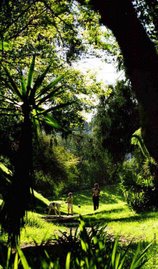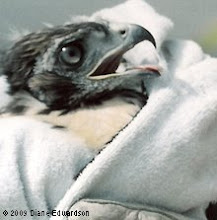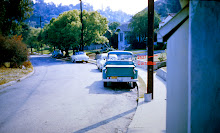 Photo: Diane Edwardson, January 29, 2010. Female American Kestrel at the Living Desert. (Click on photo to enlarge.)
Photo: Diane Edwardson, January 29, 2010. Female American Kestrel at the Living Desert. (Click on photo to enlarge.)We frequently get questions from neighbors about birds of prey. It is unlikely you would ever get this close to Kestrels in the neighborhood. These Kestrels are non-releasable rescues residing at the Living Desert in Palm Desert, CA.
 Photo: Diane Edwardson, January 29, 2010. Female Kestrels have more stripes on their back, tail & chest. (Click on photo to enlarge.)
Photo: Diane Edwardson, January 29, 2010. Female Kestrels have more stripes on their back, tail & chest. (Click on photo to enlarge.)Kestrels are the smallest falcons (8 - 12") and are native to the neighborhood. They eat insects. Kestrels are often found perched atop tall trees and on power lines. We used to see them frequently hunting from the power lines going up the Corralitas public staircase and atop trees on the 2 Freeway and Semi Tropic Spiritualists' Tract.
 Photo: Diane Edwardson January 29, 2010. Male Kestrels are more solid colored. (Click on photo to enlarge.)
Photo: Diane Edwardson January 29, 2010. Male Kestrels are more solid colored. (Click on photo to enlarge.)Ingenious Urban Adaptation
Every year a male Kestrel used a neighbor's satellite dish to broadcast his mating call. He would perch on the edge of the 12-foot diameter dish atop Corralitas Drive and call into it, amplifying the sound.
 Photo: Diane Edwardson, January 29, 2010. Compare the female Kestrel, in the foreground, with the male, in the background, handled by trained docents at the Living Desert. (Click on photo to enlarge.)
Photo: Diane Edwardson, January 29, 2010. Compare the female Kestrel, in the foreground, with the male, in the background, handled by trained docents at the Living Desert. (Click on photo to enlarge.)Several years ago, the Kestrels nested on Corralitas Drive. They seemed to be teaching the babies how to fly from the eucalyptus, just below the log cabins, where there is a steep drop to the roadway below.
Sadly, Kestrel sightings have not been frequent since the Red Tail Hawks nested on Corralitas in 2005.
Learn more about Kestrels at the Cornell Lab of Ornithology.


